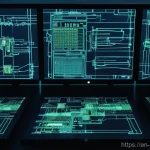Hey everyone! It’s amazing to think about how much our world has changed, isn’t it? Just a few years ago, coding felt like this super exclusive club, only for the tech gurus.
But honestly, that couldn’t be further from the truth today! I’ve seen firsthand how understanding even the basics of programming can unlock incredible opportunities, not just for career techies but for *everyone*.
Whether you’re dreaming of building the next big app, automating those annoying daily tasks, or simply want to understand the digital world that surrounds us, knowing how to “talk” to computers is becoming as fundamental as reading or writing.
It’s truly a game-changer, fostering a problem-solving mindset that transcends any single field. I remember when I first dipped my toes into coding, thinking it was all about complex jargon, but I quickly realized it was more about logical thinking and breaking down challenges into manageable steps.
And with AI tools evolving at lightning speed, coding isn’t disappearing; it’s transforming, empowering us to achieve even more with smarter assistance.
Forget endless memorization; it’s about grasping those core concepts that are surprisingly consistent across languages. Trust me, once you get the hang of variables, loops, and functions, a whole new world of creation opens up.
Ready to start your journey into this empowering skill and see how it can totally revamp your perspective and potential? Let’s dive in and truly demystify programming basics together!
Demystifying the Digital Language: What’s Under the Hood?

It’s easy to feel intimidated when you first hear terms like “syntax” or “algorithms,” but honestly, it’s not rocket science. Think of programming like learning a new spoken language, but instead of talking to people, you’re talking to a computer.
And just like any language, there are fundamental building blocks. When I first started, I imagined it would be all complex equations, but what I found was something much more intuitive: a way to give precise instructions.
The beauty of it is that once you grasp these core concepts, they apply across almost every programming language out there. It’s like learning the alphabet; once you know it, you can read any book.
This initial understanding is what truly clicked for me, turning a daunting challenge into an exciting puzzle. I realized that behind all the intimidating jargon, there’s a surprisingly logical and straightforward system waiting to be explored.
It’s all about breaking down big ideas into smaller, manageable steps, which is a skill that helps you not just in coding, but in life too!
Variables and Data Types: Your Digital Building Blocks
Every program, no matter how simple or complex, needs to store information. That’s where variables come in. Imagine a variable as a labeled box where you can put different kinds of stuff – numbers, text, true/false statements.
When I first learned about them, I thought, “Oh, so it’s just like algebra, but for words too!” And that’s pretty much it. You give the box a name, say or , and then you put the actual data inside.
The “kind of stuff” you put in the box is what we call a data type. Is it a whole number (an integer), a number with decimals (a float), a string of characters (text), or a simple true or false (a boolean)?
Understanding these basic types is crucial because they dictate what you can do with the data. For instance, you can do math with numbers, but not with text in the same way.
My early mistakes often involved trying to add a string to an integer, leading to funny errors until I truly grasped how data types work and why they matter.
It’s like trying to mix oil and water; they just don’t play well together without a specific process.
Operators and Expressions: Making Sense of the Math
Once you have your variables holding data, you’ll want to do things with that data. That’s where operators come into play. These are the symbols that tell the computer to perform an action, like adding two numbers (), subtracting (), multiplying (), or dividing ().
We also have comparison operators, which help us ask questions like “Is greater than ?” () or “Are and the same?” (). When you combine variables, operators, and values, you create expressions.
An expression is basically a piece of code that evaluates to a single value. Think of it as a mini-equation. For example, is an expression that calculates the tax amount.
I remember trying to write a simple calculator program and constantly mixing up (for checking equality) with (for assigning a value). It’s a classic beginner mistake, but it really hammered home the importance of paying attention to these small but mighty symbols.
It’s these small building blocks that allow us to create incredibly sophisticated calculations and logical flows in our programs.
Bringing Your Ideas to Life: The Magic of Control Flow
So, you’ve got your data stored in variables, and you know how to perform basic operations. What next? How do you make your program *do* something intelligent, like decide to send an email only if certain conditions are met, or repeat a task a hundred times without you manually telling it to?
This is where control flow comes in, and it’s truly where programming starts to feel like magic. It’s the engine that drives your code, allowing it to make decisions and perform actions repeatedly, bringing your static instructions to life.
When I first started, I thought I’d have to write out every single step. But then I discovered conditional statements and loops, and it felt like I’d found a superpower.
Suddenly, my programs weren’t just following a linear path; they were adapting, responding, and automating in ways I hadn’t imagined possible. It changes your entire perspective on problem-solving, making you look for patterns and opportunities for automation everywhere.
Conditional Statements: When to Do This, When to Do That
Life is full of decisions, and so are programs. Conditional statements are how your code makes choices. The most common one you’ll encounter is the statement.
It’s pretty straightforward: a certain condition is true, do this specific block of code. Otherwise, , do something different. For example, then display “It’s a hot day!”.
If not, , display “It’s pleasant outside.” You can even chain these with to handle multiple scenarios. I remember building a simple game where the character’s movement depended on pressing different arrow keys.
Each key press was an statement, checking which key was down. Initially, I had a hard time visualizing the flow, but drawing it out like a flowchart really helped.
It’s all about clearly defining the conditions and the actions that follow, ensuring your program behaves exactly as you intend under various circumstances.
This foundational concept is what enables intelligent behavior in software, from simple apps to complex AI systems.
Loops: Mastering Repetition with Finesse
Imagine having to tell your computer to print “Hello!” a thousand times. Would you type a thousand times? Absolutely not!
That’s where loops save the day, and your sanity. Loops allow you to execute a block of code multiple times without writing it over and over. The two main types you’ll often see are loops and loops.
A loop is great when you know exactly how many times you want to repeat something, like iterating through a list of items. A loop, on the other hand, keeps going as long as a certain condition remains true.
I once had a task to process every file in a folder, and without a loop, it would have taken me hours of manual clicking and dragging. Instead, a few lines of code did it in seconds.
It was a true “aha!” moment, showing me the sheer efficiency and power that loops bring to programming. It’s a fundamental concept that transforms repetitive, tedious tasks into quick, automated processes, freeing you up for more creative problem-solving.
The Power of Reusability: Functions and Modules
As you start writing more complex programs, you’ll quickly realize that you’re often performing the same actions or calculations in different parts of your code.
Copy-pasting code is not only tedious but also a recipe for disaster when you need to make changes later. That’s where the concept of functions and modules becomes your best friend.
They allow you to write a block of code once and then use it whenever and wherever you need it, making your programs cleaner, easier to understand, and much more manageable.
When I first discovered functions, it felt like I’d gone from building with individual LEGO bricks to using pre-assembled components – a huge leap in efficiency and organization!
It’s all about encapsulation and abstraction, which basically means putting related code together in a neat package and giving it a descriptive name. This approach dramatically reduces the complexity of large projects and helps you maintain sanity as your codebase grows.
Crafting Your Own Tools: The Beauty of Functions
A function is essentially a self-contained block of code that performs a specific task. You define it once, give it a name (like or ), and then you can “call” or “invoke” that function whenever you need its functionality.
Functions can also take “arguments” – inputs that they use to perform their task – and they can “return” a result. For example, a function might take and as arguments and return the final tax amount.
I remember creating my first few functions and feeling like a digital architect, building custom tools for my programs. It made my code so much more readable because instead of seeing the same five lines repeated, I’d just see .
Debugging also became a breeze because if something was wrong with the tax calculation, I knew exactly which function to check, instead of hunting through scattered lines of code.
It’s a game-changer for code organization and efficiency.
Keeping Things Tidy: Organizing with Modules
As your projects grow, you’ll find yourself with many functions. To keep things from becoming a chaotic mess, you can group related functions and other code into what we call modules (or sometimes libraries or packages, depending on the language).
Think of a module as a toolkit specifically designed for a certain purpose. For example, you might have a module containing functions for advanced calculations, or a module for functions related to interacting with websites.
When you need something from that toolkit, you simply “import” the module into your program. This not only keeps your main code tidy but also promotes code reuse across different projects.
My experience with larger projects taught me quickly that good module organization is key to collaborative coding and long-term project maintainability.
Without it, you quickly find yourself lost in a labyrinth of files and functions. It’s like having a well-organized workshop where every tool has its place, making every project much smoother.
Debugging: Your Best Friend in the Coding Journey
Let’s be real: writing perfect code on the first try is about as common as spotting a unicorn. You *will* make mistakes, your code *will* have bugs, and things *will* go wrong.
And that’s totally okay! Debugging isn’t a sign of failure; it’s an integral part of the programming process, and frankly, it’s where some of the most satisfying problem-solving happens.
When I first started, I used to get so frustrated when my code didn’t run, thinking I was just bad at it. But over time, I learned to see errors not as roadblocks, but as clues, guiding me toward the solution.
Learning to debug effectively transformed my coding experience from a series of exasperating dead-ends into a detective mission, uncovering the root cause of issues.
It really teaches you patience and methodical thinking, skills that extend far beyond just writing code.
Why Errors Aren’t the Enemy
When your program crashes or doesn’t behave as expected, the error messages might look scary, but they’re actually your program trying to tell you what went wrong.
They point you in the right direction, often indicating the file, line number, and even the type of error. Learning to read and understand these messages is one of the most valuable skills you can develop.
Initially, I’d just stare at them blankly, but with practice, I started to decipher them, realizing they’re not accusations, but helpful hints. I’ve learned that sometimes the error isn’t where the message points, but a few lines above, where a variable wasn’t properly initialized, for example.
It’s a bit like a scavenger hunt, and each error message is a clue leading you closer to the treasure of a working program. Embracing this mindset makes the process much less daunting and even a little bit fun.
Common Pitfalls and How I Tackled Them

Through countless hours of coding and debugging, I’ve stumbled upon a few common culprits that often lead to bugs. Forgetting a closing parenthesis or bracket is a classic – it’s like leaving a sentence unfinished!
Mismatched data types (trying to add text to a number) often cause issues, as does mixing up assignment () with comparison (). Another sneaky one is off-by-one errors in loops, where your loop runs one time too many or too few.
I remember spending an entire afternoon trying to figure out why my list was missing the last item, only to realize my loop condition was slightly off.
My go-to strategy these days involves using print statements to see the values of variables at different points in my code, or utilizing a debugger to step through my program line by line.
It’s like shining a flashlight into the dark corners of your code, revealing exactly what’s happening and when.
| Debugging Tip | Description | Why It Helps |
|---|---|---|
| Read Error Messages Carefully | Don’t just panic! Error messages often contain valuable clues about what went wrong. | Directs you to the specific problem area and type of error. |
| Use Print/Log Statements | Temporarily insert commands to display variable values or execution flow. | Gives you insight into the program’s state at various points, helping to pinpoint issues. |
| Step Through Code with a Debugger | A tool that allows you to execute your code one line at a time and inspect variables. | Provides a detailed, real-time view of your program’s execution, invaluable for complex bugs. |
| Simplify the Problem | If a complex piece of code isn’t working, try to isolate the problematic part or reproduce the error with minimal code. | Reduces complexity, making it easier to identify the source of the bug. |
Picking Your First Language: Where to Begin?
With so many programming languages out there, it’s natural to feel a bit overwhelmed when trying to decide where to start. It’s like walking into a massive library and not knowing which book to pick up first.
My advice? Don’t overthink it! The core concepts we’ve discussed – variables, loops, functions – are universal.
What changes is the “syntax” – the specific rules and keywords of each language. So, picking your first language is less about choosing “the best” and more about choosing one that’s beginner-friendly, has a great community, and opens doors to exciting possibilities.
I’ve always told friends that the goal isn’t to master one language, but to use your first language as a stepping stone to understand programming logic, which then makes learning any subsequent language much, much easier.
It’s about building a foundation, not just a single wall.
Python: The Gentle Giant for Beginners
If you ask most developers today for a recommendation for a first language, Python will almost certainly come up. And for good reason! Its syntax is incredibly readable, almost like plain English, which drastically lowers the barrier to entry.
I personally started with another language, but when I later picked up Python, I was blown away by how quickly I could write functional code. It’s also incredibly versatile – you can use Python for web development, data science, artificial intelligence, automation, and so much more.
The community around Python is enormous and incredibly supportive, meaning if you ever get stuck, a quick search will likely yield hundreds of helpful answers.
Plus, there are tons of free resources, tutorials, and courses available, making it super accessible. If you’re looking for a language that’s powerful yet easy to learn, Python is a fantastic choice that won’t leave you feeling frustrated.
JavaScript: The Language of the Web
If your goal is to build interactive websites, then JavaScript is non-negotiable. It’s the language that brings websites to life, enabling everything from animated menus to complex web applications.
Virtually every browser understands JavaScript, making it an incredibly powerful tool for anyone interested in front-end development (what users see and interact with).
While it might have a steeper learning curve than Python for absolute beginners, its immediate visual feedback – seeing your code change a webpage right before your eyes – can be incredibly motivating.
When I started experimenting with web development, seeing my JavaScript code actually *do* something on a webpage was a huge thrill and kept me going through the trickier parts.
Plus, with frameworks like Node.js, you can even use JavaScript for back-end development, making it a full-stack powerhouse. If you’re passionate about creating for the web, diving into JavaScript will open up a world of possibilities.
Beyond the Code: The Mindset of a Modern Coder
Learning the syntax and rules of a programming language is just one part of the journey. To truly thrive as a developer in today’s rapidly evolving tech landscape, it’s equally important to cultivate a certain mindset.
This isn’t just about writing lines of code; it’s about how you approach problems, interact with others, and continually expand your knowledge. When I reflect on my own growth in this field, I realize that some of the most crucial lessons weren’t about a specific language feature, but about developing a way of thinking that makes tackling any coding challenge much more manageable and even enjoyable.
It’s about embracing challenges, learning from mistakes, and always staying curious. The tech world moves fast, and the ability to adapt and grow is far more valuable than memorizing every command.
Problem-Solving Like a Pro
At its core, programming is problem-solving. It’s about taking a big, often ambiguous problem and breaking it down into smaller, manageable pieces, then figuring out the logical steps to solve each piece.
This isn’t something you’re born with; it’s a skill you develop over time through practice and perseverance. I’ve found that the best coders aren’t necessarily the ones who know the most languages, but the ones who can think critically and logically about how to achieve a desired outcome.
My personal approach often involves grabbing a pen and paper, sketching out ideas, and outlining steps before I even touch the keyboard. It helps to clarify my thoughts and identify potential roadblocks early on.
This methodical approach, often called “computational thinking,” is truly the superpower that every programmer needs to cultivate.
The Importance of Community and Continuous Learning
The tech world is constantly changing, with new languages, frameworks, and tools emerging all the time. This means that learning to code isn’t a one-and-done event; it’s a continuous journey.
The moment you think you know everything, you’ve probably fallen behind! This might sound daunting, but it’s also incredibly exciting. There’s always something new to learn, a new challenge to tackle.
And you don’t have to do it alone! The programming community is one of the most vibrant and supportive out there. Forums, online communities, meetups – these are invaluable resources for asking questions, sharing knowledge, and getting inspiration.
I wouldn’t be where I am today without the countless helpful articles, tutorials, and answers from other developers online. Engaging with the community not only helps you solve immediate problems but also keeps you motivated and connected to the broader world of tech.
Never stop learning, and never stop sharing!
Closing Thoughts
And there you have it, a quick tour through the exciting world of programming fundamentals! It’s been quite a journey reflecting on these core concepts, and I truly hope this dive into the digital language has made it feel less like an enigma and more like a thrilling new skill waiting for you to master. Remember, every expert programmer started right where you are now, grappling with variables, loops, and those ever-present, sometimes maddening, error messages. My own path has been filled with countless “aha!” moments, frustrating bugs that turned into invaluable lessons, and the sheer joy of watching a piece of code I wrote actually *do* something. It’s a field that constantly challenges you, but also incredibly rewards your persistence and creativity. The real magic isn’t just in the code itself, but in the problem-solving mindset you develop, the communities you become a part of, and the endless possibilities you unlock. So, take that first step, embrace the learning curve, and get ready to build something amazing. Your digital adventure is just beginning, and trust me, it’s going to be an incredibly rewarding ride.
Handy Tips You’ll Appreciate
1. Embrace the Small Victories and Start Simple. It’s incredibly tempting to want to build the next big app or intricate game right out of the gate, but trust me on this: starting with small, manageable projects is the key to sustained progress and avoiding burnout. My early days were often spent trying to tackle problems far too complex for my skill level, leading to frustration. Now, I always advise breaking down ambitious goals into tiny, achievable steps. Think about building a simple calculator, a basic to-do list, or a “guess the number” game. Each successful small project gives you a massive confidence boost and solidifies your understanding of core concepts, which then naturally paves the way for tackling those bigger, more exciting challenges. It’s like learning to walk before you run – absolutely essential for building a strong foundation and keeping your motivation high.
2. Consistency Trumps Intensity Every Single Time. In the world of coding, showing up consistently for short, focused periods is far more effective than cramming long, intense sessions once a week. I’ve personally experienced the power of this approach. Even just 30 minutes to an hour of coding daily or every other day can lead to incredible breakthroughs. It keeps the concepts fresh in your mind, helps build muscle memory for typing and debugging, and prevents that overwhelming feeling of having to relearn everything after a long break. Plus, regular exposure allows your brain to process and consolidate information even when you’re not actively coding. It fosters a habit, and habits, when it comes to learning a complex skill like programming, are your absolute best friend. Make it a part of your routine, like having your morning coffee, and watch your skills steadily grow.
3. Your Best Friend is a Bug: Learn to Love the Errors. I know, it sounds counterintuitive. When you’re new to coding, error messages can feel like a personal attack, a sign that you’ve failed. I certainly felt that way! But over time, I’ve come to view bugs and error messages as invaluable teachers. They’re not there to punish you; they’re your program’s way of telling you exactly what went wrong and often, precisely where to look. Learning to patiently read and interpret these messages, rather than just restarting or giving up, is one of the most powerful skills you can develop. It’s like being a detective, gathering clues to solve a puzzle. The satisfaction of finally squashing a tricky bug, especially one that kept you up late, is incredibly rewarding and significantly deepens your understanding of how your code really works under the hood. Don’t fear them; embrace them as stepping stones to mastery.
4. Connect with Your Tribe: The Power of Community. You absolutely do not have to walk this coding journey alone. In fact, one of the most enriching parts of my experience has been connecting with the vibrant, diverse, and incredibly supportive programming community. Whether it’s online forums like Stack Overflow and Reddit’s r/learnprogramming, local meetups, or even just a coding buddy, having people to bounce ideas off of, ask questions, or commiserate with when a bug just won’t quit, is priceless. I’ve learned so much from others, both from their advice and from seeing how they tackle problems. It’s a fantastic way to stay motivated, discover new tools, and realize that everyone faces challenges. Don’t be shy; jump in, ask questions, and eventually, you’ll be able to pay it forward and help others on their path. The collective wisdom of the community is a resource you absolutely shouldn’t overlook.
5. Build, Build, Build: Theory Only Gets You So Far. Reading tutorials, watching videos, and understanding concepts are crucial, but the real learning, the kind that sticks, happens when you start building things. My biggest leaps in understanding always came when I stopped passively consuming information and actively started writing my own code. It doesn’t have to be groundbreaking; recreate a simple website, automate a small task on your computer, or even just build a command-line utility. The act of turning theoretical knowledge into a functional piece of software forces you to grapple with actual challenges, debug real-world issues, and truly understand how all the pieces fit together. Plus, having a portfolio of personal projects, no matter how small, is fantastic for demonstrating your skills and passion to potential employers. So, get your hands dirty, experiment, and enjoy the process of bringing your digital ideas to life!
Key Takeaways
Ultimately, learning to code is more than just memorizing syntax; it’s about cultivating a problem-solving mindset and joining a dynamic, supportive community. We’ve seen that understanding core concepts like variables, control flow, and functions is foundational, enabling you to build increasingly complex and intelligent programs. Debugging isn’t a setback but a crucial part of the learning process, and choosing a beginner-friendly language like Python or JavaScript can provide an excellent springboard for your journey. My personal experience has shown me that consistency, a willingness to experiment, and the courage to ask questions are far more valuable than innate genius. This field is constantly evolving, making continuous learning and engaging with others vital for long-term growth and success. Embrace the challenge, enjoy the creative process, and remember that every line of code you write brings you closer to becoming a skilled digital creator.
Frequently Asked Questions (FAQ) 📖
Q: Why should I bother learning to code if I’m not planning on a tech career?
A: Oh, this is such a fantastic question and one I hear all the time! I get it, not everyone dreams of becoming a software engineer, and that’s perfectly fine.
But here’s the thing I’ve personally discovered: coding isn’t just for tech gurus anymore. Think of it less as a job skill and more as a life skill for the 21st century.
Seriously! For starters, it supercharges your problem-solving abilities. You learn to break down big, intimidating challenges into smaller, manageable steps – a skill that’s incredibly valuable whether you’re planning a marketing campaign, organizing a charity event, or even just tackling your household budget.
I’ve used simple scripts to automate mind-numbingly repetitive tasks in my own business, freeing up hours of my time that I could then spend on more creative work or, let’s be honest, enjoying a good cup of coffee!
Plus, understanding the basics of how software works gives you a massive advantage in any field. You’ll speak the language of innovation, allowing you to collaborate more effectively with tech teams, understand emerging technologies, and even spot new opportunities others might miss.
It’s like having a secret superpower that makes you more efficient, more analytical, and frankly, more capable in almost anything you set your mind to.
It’s truly about empowerment, not just employment.
Q: Isn’t coding really hard and full of complicated math? I’m not a “math person.”
A: Okay, let’s bust this myth right now because it’s probably the biggest barrier for so many folks, and it was certainly a fear of mine when I first started!
The honest truth is, while certain specialized areas of computer science do involve advanced mathematics, the vast majority of introductory programming and even many professional development roles require surprisingly little beyond basic arithmetic.
My own journey started with a healthy dose of skepticism about my math skills, but I quickly realized that coding is far more about logic and pattern recognition than it is about calculus or algebra.
It’s like solving a puzzle, but you’re building the pieces yourself. You’re learning to tell a computer, step-by-step, exactly what to do. Think of it as writing instructions for a very, very diligent (but not very smart) assistant.
I remember struggling with my first “for loop,” feeling totally lost, but once it clicked, it was like a lightbulb went off! The feeling of seeing your code run and do exactly what you intended?
Pure magic. There are tons of beginner-friendly languages out there, like Python, that read almost like plain English. You’re not going to be deriving complex equations; you’ll be asking “if this, then do that” and “repeat this action X number of times.” Trust me, if you can follow a recipe or assemble IKEA furniture, you’ve got the logical thinking skills to learn to code.
It’s much more accessible than you might think!
Q: With
A: I becoming so powerful, will coding even be relevant in a few years? A3: This is another super timely question, and I hear it echoing across countless conversations right now!
It’s easy to look at the incredible leaps AI has made and wonder if traditional coding is on its way out. But from where I stand, having watched this space closely and even experimented with AI tools in my own projects, I’d say the opposite is true: coding is becoming more relevant, just in a different, more powerful way.
Think of AI as an incredibly sophisticated tool, and knowing how to code is knowing how to wield that tool effectively. AI isn’t going to replace the need for human creativity, critical thinking, or the ability to define problems; it’s going to amplify them.
We’re moving from a world where you had to write every single line of code yourself to one where AI can help you generate snippets, debug faster, or even translate ideas into initial code structures.
But you still need to understand what the AI is doing, how to prompt it correctly, and how to integrate its outputs into a larger, functional system. I’ve personally found AI to be an incredible assistant, helping me brainstorm and write boilerplate code much quicker, which then frees me up to focus on the truly interesting, complex parts of a project – the stuff that requires human ingenuity.
So, instead of being obsolete, coding skills will empower you to become a ‘super-user’ of AI, leveraging its power to build things we couldn’t even dream of just a few years ago.
It’s not about AI replacing coders; it’s about coders, armed with AI, achieving exponentially more.






